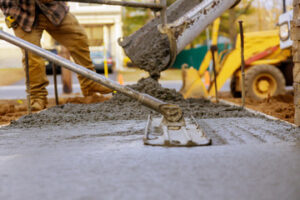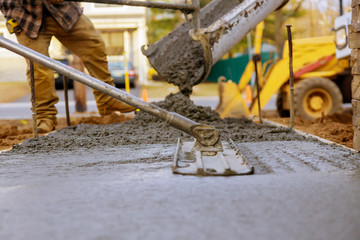A damaged concrete surface can be a health hazard for children and the elderly. It exposes them to accidents like falling and becoming seriously injured or even killed. For professional expertise, consult Concrete Contractors Dallas TX.
 Repairing concrete structures requires the right material and the correct technique. Contractors must address the underlying cause of damage. This may include injecting epoxy, repairing cracks, or reforming a concrete step.
Repairing concrete structures requires the right material and the correct technique. Contractors must address the underlying cause of damage. This may include injecting epoxy, repairing cracks, or reforming a concrete step.
Cracks in concrete can indicate a serious structural problem. Often, these cracks are a result of a faulty foundation. However, they can also be due to non-structural issues such as a poor mix of concrete or settlement. If these cracks are not repaired, they may lead to further damage and cost more money to fix. Several different methods can be used to repair concrete cracks.
A concrete crack sealing product that contains a bonding adhesive is the best option for this type of crack. It will help keep the repair material from coming loose and help with the adhesion of future concrete repairs. This type of product can be purchased at most home improvement centers. A good concrete crack repair product includes a foam backer rod to provide extra support. This will help the sealant to “key” into the crack and form a mechanical bond, as well as a chemical one.
Narrow cracks can be filled with a wide range of concrete repair products, including masonry epoxy and polyurea. When using these products, it is important to follow the directions carefully. It is also recommended that the crack be brushed clean with a wire brush and pressure washer to remove any dirt or debris from the crack surface. It is also helpful to use a crack chaser or 4-inch angle grinder with a concrete crack chasing wheel to widen the base of the crack and remove any sharp edges within.
Larger cracks in concrete can be repaired by grouting or concrete patching. Concrete patching products are available in a variety of colors to match the surrounding concrete and can be troweled on with a power or hand trowel. These products should be mixed with water prior to application. It is important to note that the patching materials are only temporary and must be reinforced with steel bars or rebar if the concrete is to be used for structural purposes.
A more permanent solution to cracks in concrete is called crack stitching. This method involves the use of U-shaped metal bar of varying lengths to bridge the two sides of the crack. It is not as effective for active cracks but can stop the movement of cracks and prevent them from spreading.
Delamination
Delamination is the separation of concrete’s surface layer from its underlying mass. This can be caused by the failure of the surface material or by a problem with the construction. It is most common with troweled concrete and can be exacerbated by weather conditions and finishing practices. It can also occur as a result of disruptive stresses like chloride-induced corrosion of steel reinforcement or poorly bonded areas in two-course construction. Delaminations that occur deeper in the structure are called spalling (see Spalls).
The most common solution to delamination is patching the affected area with a concrete repair mix. However, in structural applications – especially those caused by water corrosion of imbedded steel rebar – removing the damaged section, going through an extensive clean and then replacing it with a new section is often necessary.
Incipient or developing delaminations typically sound solid when tapped with a hammer or chain dragged because the densified surface layer is still somewhat attached to the body of concrete. But over time, the weakened layer breaks down under floor loading (especially forklift traffic) and separates from the floor surface.
To properly identify a delamination, you need to have the right tools. A hammer and spray paint is the most economical, easy to use tool. A hammer that emits a sharp, hard sound when struck will reveal the underlying concrete as opposed to a dull sound when hitting a delaminated surface. More sophisticated methods of identifying a delamination include impact-echo and ground-penetrating radar.
Before starting a concrete repair, you should always check the concrete to make sure it is saturated surface dry (SSD). This means that the concrete looks wet but is completely dry. If you can’t get the surface to SSD, you will need to use a chemical bonding agent before proceeding.
The best concrete repair materials are typically high quality concrete mixes with added polymers. These polymers improve the workability and bonding of the repair material and help it to achieve higher strength. Bagged concrete mix manufacturers are seeing an increased demand for mixes that are easier to mix – and they have responded by introducing products with lower silica content and added additives that help the material resist cracking.
Moisture
Concrete is a very durable material that can handle quite a bit of abuse, but it’s not immune to water damage. If left untreated, water damage within concrete can weaken its structure and lead to further issues such as mold growth or structural failure. Concrete water damage can be caused by plumbing leaks, running groundwater below the slab or simply from bad installation. Whether the damage is due to water from outside or within, there are steps that can be taken to repair it.
A common problem that can be fixed by a concrete repair company is water damage within a concrete foundation. To address this, property restoration companies can help with removing standing water and determining the level of moisture. Using a moisture meter, they can then determine the best way to move forward with repairing the damage. Depending on the severity, this may include rinsing the area and then injecting the concrete with moisture-tolerant epoxy.
Moisture in concrete is a problem that affects the lifespan of any coating or surface applied to it. In concrete repair, this can lead to problems such as delamination, cracks and discoloration of the surface. It can also prevent any water-based adhesives from bonding properly with the concrete.
In general, a concrete slab needs time to dry and cure completely. While there are times where a concrete job is on a tight deadline and workers need to speed things up, this can be dangerous to the integrity of the slab.
When concrete is not allowed sufficient time to dry, internal moisture vapor can move upward through tiny air holes in the concrete. This can cause tile to lift off the floor, hardwood to rot, carpet to get damp and mildewy and concrete coatings to delaminate.
One of the most effective ways to reduce moisture in concrete is to allow it adequate curing time. If this is done, it can reduce the risk of cracking, surface scaling, delamination and blistering. Another option is to use a vapor barrier to prevent external water from seeping through the concrete and causing these issues.
Adhesives
Concrete adhesives can help prevent cracks and complete projects like laying new flooring, repairing exterior siding or gluing stone veneers. However, it is important to understand the type of adhesive used is key to a successful bond. For example, if you are working in cold temperatures it is essential to use an adhesive that can withstand freezing and thawing. The best concrete glue is one that is formulated to be able to do this.
The first step in the adhesive process is to prepare the surface where it will be bonded. Ensure that both surfaces are free of dust, dirt, grease and paint to ensure maximum adhesion. This can be done by using a jet wash or sandblasting for the most effective results. The concrete should be rinsed thoroughly after cleaning to remove any remaining particles. Once the surface is cleaned, it should be allowed to dry before using an adhesive.
Most common concrete adhesives are mastic adhesives. They can be purchased at most home improvement stores. However, they have several drawbacks that limit their effectiveness in many applications. These include a low initial grab and bond strength, requiring the use of temporary supports until they fully cure. This can increase project time and labor costs. Additionally, mastic adhesives are not waterproof and can be damaged by moisture exposure.
An epoxy concrete adhesive has a higher initial grab and bond strength. It is also more flexible and waterproof, allowing it to withstand changes in temperature and moisture. It can be used in outdoor and wet environments to bind wood, metals, ceramics and most other materials to concrete.
When using an epoxy concrete adhesive, it is critical to follow the manufacturer’s instructions. Generally, the adhesive will need to be mixed with water to create a slurry. This is important because the slurry will be able to penetrate deeper into the concrete to bond with it. If the slurry is not mixed correctly, it may not adhere to the concrete properly.

